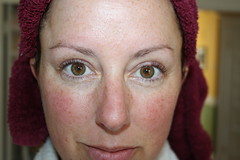 Image by kristiewells via FlickrRosacea is a common skin disease that frequently begins as a tendency to flush or blush easily. As rosacea progresses, people often develop persistent redness in the center of the face. This redness may gradually spread beyond the nose and cheeks to the forehead and chin. Even the ears, chest, and back can be affected.
Image by kristiewells via FlickrRosacea is a common skin disease that frequently begins as a tendency to flush or blush easily. As rosacea progresses, people often develop persistent redness in the center of the face. This redness may gradually spread beyond the nose and cheeks to the forehead and chin. Even the ears, chest, and back can be affected.
WHAT ROSACEA LOOKS LIKE
Tiny blood vessels, which many call spider veins, can develop. Some people see small red bumps. Usually appearing in crops, some of the red bumps may contain pus. Dermatologists call the pus-filled bumps pustules. If the bumps do not contain pus, they are called papules. These pustules and papules resemble acne, so people often refer to rosacea as adult acne. Unlike with acne, blackheads do not develop. Rosacea also can cause the affected skin to swell.
In more advanced cases, a condition called rhinophyma may develop. Caused by enlarged oil glands in the skin, rhinophyma makes the nose larger and the cheeks puffy. Thick bumps may develop on the lower half of the nose and nearby cheeks. Most people do not develop rhinophyma; those who do tend to be men.
Rosacea also can affect the eyes. About 50 percent of people with rosacea have eye involvement, also called ocular rosacea. This often causes dryness, burning, and grittiness of the eyes. Left untreated, ocular rosacea can lead to serious eye complications.
SIGNS OF ROSACEA
Early rosacea can be difficult to recognize. When rosacea first develops, the redness tends to come and go. Many people may consider this nothing more than flushing that lasts longer than normal. The visible blood vessels can be seen as an inevitable sign of aging. If papules and pustules appear, these can be mistaken for adult acne.
When the skin returns to its normal color and other signs such as pimples and visible blood vessels appear, it is best to see a dermatologist. Left untreated, rosacea can worsen and become more difficult to treat.
Self-diagnosis and at-home treatment are not recommended. Some over-the-counter treatments can worsen rosacea.
THOSE AT RISK
Although fair-skinned adults between the ages of 30 and 50 may be at greater risk, people of all races and ethnic groups can develop rosacea. It affects men and women of any age, and even children.
Because rosacea can be associated with menopause, women are affected more often than men. As women approach menopause, they may notice an extreme sensitivity to cosmetics and skin-care products. These can be symptoms of rosacea. Both men and women may notice that a particularly embarrassing or tense moment triggers flushing that lasts longer than in other people.
If you experience any of these, it is important to see a dermatologist. Rosacea tends to be a chronic (last for years) and progressive condition that rarely reverses itself.
TREATMENT
To effectively manage rosacea, dermatologists usually recommend a combination of treatments tailored to the individual patient. This approach can stop rosacea from progressing and sometimes reverses rosacea.
Many rosacea treatments are applied directly to the affected skin. Creams, lotions, foams, washes, gels, and pads that contain a topical antibiotic, azelaic acid, metronidazole, sulfacetamide, benzoyl peroxide or retinoids may be prescribed. These topicals are effective, but improvement can take time. A slight improvement may be seen in the first three to four weeks. Greater improvement usually takes about two months.
Faster results may be seen with oral antibiotics. A dermatologist may prescribe an oral antibiotic to treat the papules and pustules.
Cortisone creams may be prescribed to reduce redness, but with improper use cortisone can cause thinning of the skin. It is therefore important to follow your physician's directions and it is best to use these creams only under the direction of a dermatologist.
Persistent redness may be treated with a small electric needle (electrodessication) or laser surgery. Laser surgery can also reduce the background skin redness as well as the papules and pustules. Cosmetics also may be helpful. Green-tinted makeup may mask the redness.
For best results from a prescribed treatment plan, be sure to carefully follow the dermatologist's instructions.
TREATMENT FOR RHINOPHYMA
Surgery is the most effective treatment for rhinophyma. The excess tissue can be carefully removed with a scalpel, laser, or electrosurgery. Dermabrasion, a surgical method that smoothes the top layer of the skin, will help improve the look of the scar tissue.
TIPS FOR ROSACEA PATIENTS
Many everyday things can cause rosacea to flare. Anything that causes a flare-up is called a trigger. To help patients decrease flare-ups, dermatologists often recommend the following:
- Practice good sun protection. Sun exposure seems to be the most common trigger. Seek shade when possible, limit exposure to sunlight, wear protective clothing, and use nonirritating broad-spectrum (offers protection from UVA and UVB rays) sunscreen with SPF of 30 or higher. Reapply sunscreen every two hours.
- Avoid certain foods and drinks. Spicy foods, hot drinks, caffeine, and alcoholic beverages are common rosacea triggers. Although alcohol can worsen rosacea, the condition can be just as severe in someone who does not drink alcohol. Rosacea has been unfairly linked to alcoholism.
- Protect your skin from extreme hot and cold temperatures. These can exacerbate rosacea. Exercise in a cool environment. Do not overheat. Protect your face from cold and wind with a nonirritating scarf or ski mask.
- Avoid rubbing, scrubbing, or massaging the face.
- Avoid cosmetics and skin care products that contain alcohol or other irritating substances. Use hair sprays properly, avoiding contact with facial skin.
- Keep your skin care routine simple. Fewer products are better.
- Note flushing episodes. The above are common triggers, but what causes rosacea to flare in one person may not trigger it in another. By writing down what foods, products, activities, medications, and other things cause your rosacea to flare, you will learn your triggers.
This information comes from the American Academy of Dermatology website and should be attributed as such (www.aad.org)
 Image via Wikipedia
Image via Wikipedia








